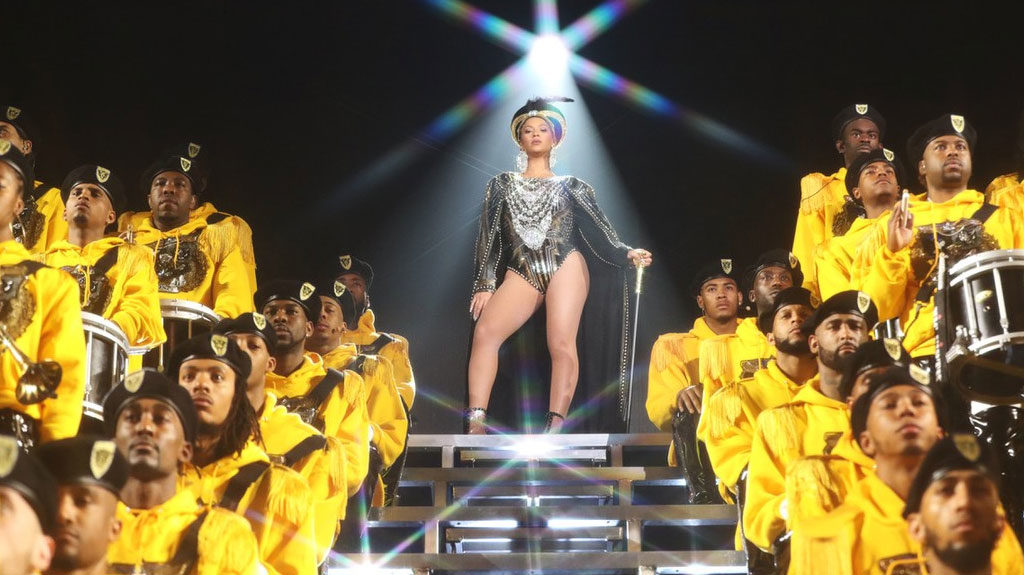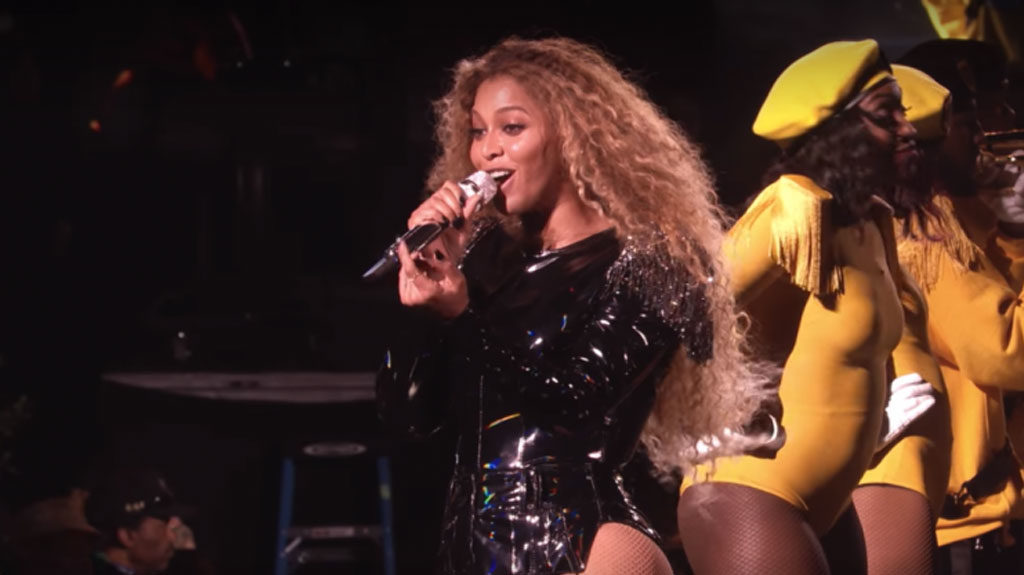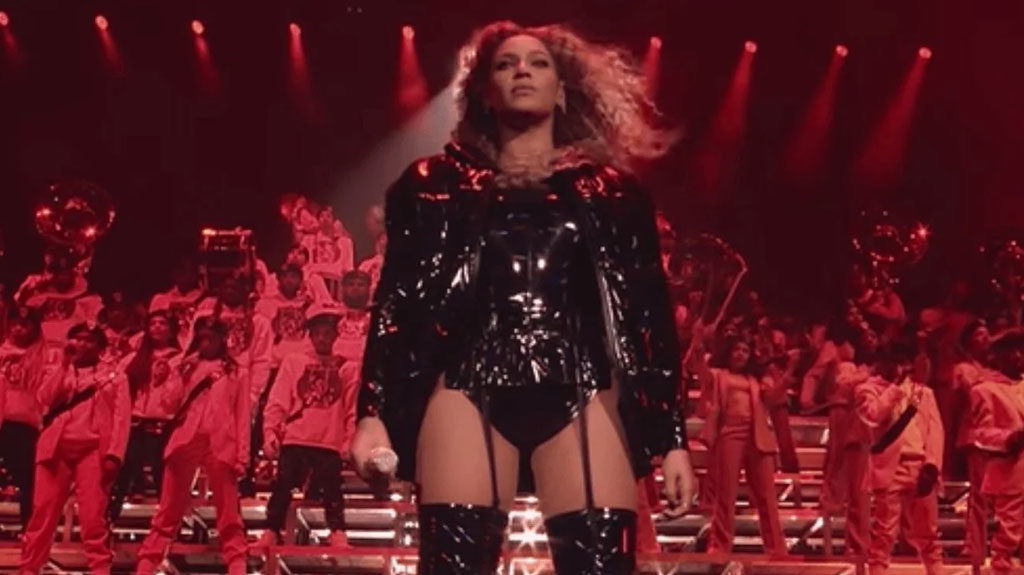Set within the milieu of the HBCU experience, Knowles’s latest masterwork captures the complexity of contemporary blackness through film, a medium that has always crystallized black representational possibility for better or worse.

About halfway through Homecoming, Beyoncé Knowles’s triumphant new Netflix film documenting the planning and performance of her headlining slot at Coachella Valley Music and Arts Festival in 2018, there’s a blank screen with text, one of many throughout the film that feature quotes from black intellectuals affiliated with America’s 101 historically black colleges and universities, or HBCUs. This one, a quote from Marian Wright Edelman, who in addition to founding the Children’s Defense Fund is proud alumna of Atlanta’s Spelman College, reads, “You can’t be what you can’t see.”
On its surface, Homecoming is a celebration of the HBCU experience, with the bleating horns, interpolated hip-hop samples, clicks and clacks of step groups, and undefeated energy of an HBCU marching band Saturday. The bands of schools such as North Carolina A&T, Bethune-Cookman, Alabama A&M, and Jackson State are often the highlights of the schools’ football games (homecoming weekend and otherwise), soundtracking the celebrations of a black nation within a nation. It has its own aesthetics—the chopped and screwed, flex, and step routines choreographed exactingly for the stage and screen. It has its own canon—of songs and samples drawn from the rich musical output of black Americans and seamlessly interpolated within the band performance (yes, that was “Swag Surfin’” within “Drunk In Love” and The Isley Brothers’ “Shout” in the midst of “Single Ladies (Put a Ring On It)”). And it has its own anthem, “Lift Every Voice and Sing,” performed masterfully by Knowles near the show’s beginning and movingly by her daughter, Blue Ivy Carter, at its denouement. All of these things are on proud display throughout the film’s two hours and 17 minutes.
For even the most ardent #Beyhive members, the #Beychella performance offers something new on every listen—a new sample, a new dance step, a new connection to a broader matrix of black culture exhaustingly detailed after the festival had ended. Homecoming educates those unfamiliar with these traditions, but just as importantly it affirms them, putting them front and center. Homecoming collects stories and sounds, amassing them in one place and preserving them in true concert. Its true import comes because its medium—film—is key to the long battle of equitable representation for black people. And in using the HBCU as its staging ground, it invites the viewer to see so much of what black experience can be.

“The medium of film has communicated, shaped, reproduced, and challenged various notions of black subjectivity in 20th Century America since D.W. Griffith’s Birth of a Nation appeared in 1915,” Dr. Guy wrote in a 2002 essay on the role of film in forming black identity titled “Muzing New Hoods, Making New Identities: Film, Hip-Hop Culture, and Jazz Music.”
Early in that article, he quotes a Langston Hughes-penned 1945 review of the aforementioned Birth of a Nation, a film that, despite its celebration of the Ku Klux Klan that inspired the Klan’s early-century rebirth, is still remarked upon as a classic of early American cinema. The film, Hughes argued, “forged the twin screen image of the Negro as bestial rapist and grinning, eye-rolling clown—stereotypes that are still with us today.”
American film crystallizes and codifies the stereotype itself, defining tropes, archetypes, and ur-symbols that take hold quickly and long-lastingly. For black people in America, that has often meant a flattening of their complex humanities: Gone with the Wind (1939), another racist “classic,” gave us the subservient Mammy; Imitation of Life (1934) the Tragic Mulatta, trapped between white appearance and black identity. Blackface minstrel shows such as those captured in Al Jolson’s The Jazz Singer (1927) relied upon and reified crude stereotypes of black life and song. The leader of the singing, dancing crows in Disney’s Dumbo (1941) is named Jim Crow, after the laws that re-inscribed segregation in early-Twentieth Century America.
So for Knowles to direct and produce a film such as Homecoming is to make an entrée into a legacy of American cinema where black people and culture are too often denied depiction in a way that is specific, multi-dimensional, and rich. That is not the case here. “When I decided to do Coachella, instead of me pulling out my flower crown, it was more important that I brought OUR culture to Coachella,” she says at one point in the documentary, suggesting a higher calling. If she was going to make her long-awaited debut as the festival’s first African American female headliner after postponing the previous year due to the complicated and dangerous pregnancy she bravely details during the film, it was going to be worth the wait.
Homecoming is so successful as a film because of a word so frequently associated with Knowles, who has labored against genre, medium, and gender boundaries her entire career: Ambition. As an artist, Knowles is dynamic, standing out even with 200 other performers moving around her. As a director, Knowles is exacting, using the film to make clear the performance’s intentions and specificity: She wanted desperately for this performance and film to be a marker of the HBCU experience—something she says “must be celebrated and protected”—and an archive of a moment in her career and in black America more broadly.
That’s at least in part why black fans were so exultant in the days following the first #Beychella performance on April 14, 2018, particularly given the festival space is often more a reminder of black artists’ lack of representation on the bill (and the lawlessness majority-white festival crowds are allowed when urban black neighborhoods remain constantly surveilled). That’s why the black fans in the front rows (many of whom apparently waited 12 hours holding their spots) are singing along to every word and when a black fan. That’s the reason its stage—a pyramid of bleachers—is now a monument, the one for our times as we tear down those that never deserved to stand in the first place.

This show—and now this film—are celebratory documents built to be testaments to the legacy of black music. At one point in the film during a rehearsal montage, she describes the process as “creating something that will live beyond me” and calls it “something I’ve worked my entire life for.” “I’m so grateful that I was able to come home,” she says. “Home,” for Knowles is the HBCU, a staging ground for the preservation and canonization of black tradition, community, and musical experience. Home is an empty soundstage with her daughter, Blue, passing on the nation’s anthem and being a truth-teller, as Maya Angelou implored listeners to do in the 2014 interview that narrates the film’s trailer and climax. “God, I ask that this is an experience that we all remember forever,” she prays. She’s given us every reason to know it will be.

 Share On Facebook
Share On Facebook Tweet It
Tweet It




